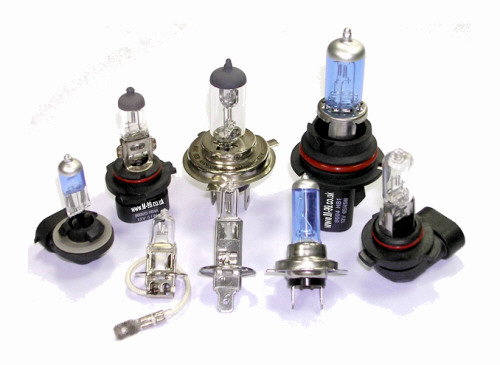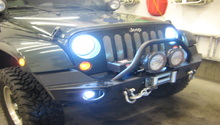Jeep Wrangler JK: Headlight Bulb Modification
Your Jeep Wrangler JK comes with basic stock halogen headlight bulbs. Read on to learn about the upgrade options available on the market today.
This article applies to the Jeep Wrangler JK (2007-Present).
Halogen, Xenon and LED. You've heard the names before, and maybe you know a little bit about one or more of these headlight bulb options for your Jeep Wrangler JK. The fact is that the stock OEM halogen bulbs provide very basic illumination of the roadway. Since they are the most common and least expensive bulb option, no one expects them to light up the night. Xenon and LED headlights offer a much brighter and longer lasting light, but they come at a price. Let's take a closer look at all of these options to see what bulbs make the most sense for your headlight upgrade.
All About the Bulbs
In the beginning, there was the halogen bulb and it was good. It's the basic bulb standard on most automobiles since the dawn of the electric headlight. It has a filament in a capsule filled with halogen gas, and it produces a bright, white light. The problem with them is they are not very energy efficient, as a lot of the energy is lost to heat. The Xenon bulbs used in High Intensity Discharge (HID) headlights replace the halogen gas with Xenon, an un-reactive gas that is colorless and odorless. While there are some bulbs that make use of the Xenon gas with a filament, the HID bulbs generate light in a sealed system with an electrical charge that starts an arc between two electrode

#1 The Halogen Bulb

DIY Cost – $25-$50
Professional Cost – $100
Skill Level – Easy; the replacement is a simple twist off and on.
The halogen bulbs are the industry standard for a number of reasons, and the main one being price. None of the other options can come close to the amount of light produced per dollar than the halogen bulbs. It functions by heating a tungsten filament with an electrical current. The halogen gas extends the life of the filament by replenishing the tungsten throughout the on/off cycles of its lifespan. A typical halogen bulb has a lifetime of about 1,000 hours under normal conditions.
Much of the energy delivered to the bulb is lost to heat. Touching the bulb can reduce its lifespan, as chemicals on the skin will reduce the bulb's ability to resist this high heat. While it does produce a bright light, it cannot compete with the levels produced by the Xenon and LED bulbs. However, there are many options for halogen bulbs at a variety of price points and sizes that will make this option tough to beat for the average driver. Recommended for drivers who want a low cost bulb.
#2 Xenon Bulbs (HID)

DIY Cost – $150 for bulbs and $150-$200 for HID conversion kits
Professional Cost – $400-$500
Skill Level – Moderate; it requires bulb replacement and wiring kit.
Xenon bulbs take the place of the halogen gas in the standard bulb. While there are incandescent bulbs options that simply use Xenon in place of other halogen gases, the standard for Xenon bulbs is for use in High Intensity Discharge (HID) headlights. There is no filament in the HID bulb—there is simply an electrical arc that travels between two electrodes that produces a bright white light with a slight blue tint produced by the Xenon gas, which is three times more powerful than that of a halogen bulb.
While halogen lights only need 12V to operate, the HID lights need 20,000 volts to ignite and 85 volts to keep running. For this reason, a ballast (power transformer) is required to transform and regulate the voltage and keep it operational. Without the ballast, there would be no light. Replacing a halogen bulb with a Xenon would therefore require an HID conversion kit. That's about $150 for the bulbs and another $150 or more for the conversion kit.
Keep in mind that the factory housing may not be suitable for the HID bulb, as the more intense light generally requires careful positioning to get the light trajectory right. A housing upgrade may also be required to meet DOT safety standards. While you may love the intense white and blue light, the drivers on the other side of the road could be seeing spots for quite some time after passing you!
HID bulbs can last up to 2,500 hours, making them a long lasting replacement option. HID headlights are found standard on most luxury brands and increasing in popularity. Recommended for drivers who want a brighter light than halogen bulbs and with a longer lifespan.
#3 LED Bulbs

DIY Cost – $150-$200
Professional Cost – $300-$400
Skill Level – Easy; it is a standard bulb replacement.
The LED headlights are becoming more and more popular these days. For one, they look unbelievably cool. Since they can create a very bright light in a minimal amount of space, manufacturers can get really creative with their designs. You have no doubt seen them on cars like the Audi A8, and they are an expensive upgrade option on many of the newer luxury models.
What's not to like? They use minimal power and produce a very bright light, illuminating a wide area in front of the vehicle. LED bulb replacements are a much more reasonable upgrade option than replacing the headlights, which could run $400 to $700, depending on the design. The main problem with LED lights is that they get very hot at the base, and this requires external cooling. Replacement bulbs generally come equipped with a fan at the base to keep them cool.
The LED bulbs have long lifespans, and prices will continue to drop. You can be sure that LED lights will become as popular in cars as they are in homes, and their benefits seem to outshine their drawbacks by an ever increasing margin. Recommended for drivers who want an upgrade with a long lifespan and more illumination on the road.
Related Discussions
- LED Headlights - JK-Forum.com
- HID Conversion Kit - JK-Forum.com
- Halogen, LED and HID Lighting - JK-Forum.com






